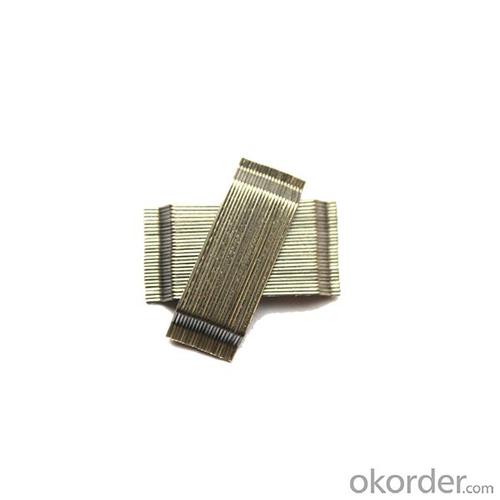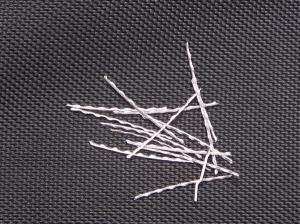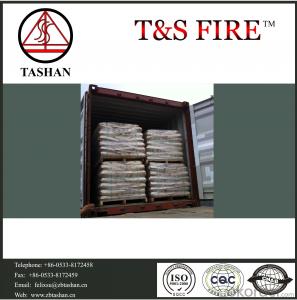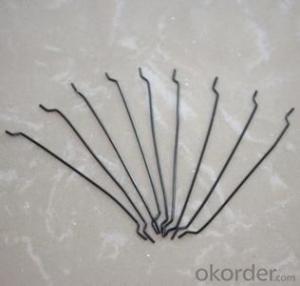Melt Extract Stainless Steel Fiber 0.75/30 Concrete Steel Fiber from CNBM China
- Loading Port:
- Tianjin
- Payment Terms:
- TT OR LC
- Min Order Qty:
- 1 m.t.
- Supply Capability:
- 5000 m.t./month
OKorder Service Pledge
Quality Product, Order Online Tracking, Timely Delivery
OKorder Financial Service
Credit Rating, Credit Services, Credit Purchasing
You Might Also Like
Quick Details
Place of Origin: Tianjin, China (Mainland)
Model Number: 0.75
Material: Steel
Production Process: Cold drawn
Lengh: 30
Type: 1
Compressive Strength: >1200MPa
Aspect ratio: 40
Standard: ASTM A820M-11
Section Shape: Circular
Application: Concrete Reinforcement
Packaging & Delivery
| Packaging Details: | 20 kg/Bag,50 bags/Pallet or 1,000kg/ Bulk Bag |
|---|---|
| Delivery Detail: | 1 Month |
Product Description
| Diameter | 0.75 | mm | 0.03 | in |
| Length | 30.00 | mm | 1.18 | in |
| Aspect Ratio | 40 | |||
| Tensile strength | 1200 MPa | |||
| Type | Cold drawn Steel Fiber | |||
| End | Hooked-end Steel Fiber | |||
| Glued/Loose | Glued Steel Fiber | |||
| Bending Angle | 45°(min.30°) | |||
| Usage & Performance | Floor:Trafficked areas and Industrial floors | |||
| Shotcrete :Slope stabilization and Final lining | ||||
| Precast concrete:Pipe and Railway sleepers | ||||
| Packing | Standard Export Pallet Packing | Bag Packing | 20 kg/Bag,50 bags/Pallet | |
| Bulk Packing | 1,000kg/ Bulk Bag | |||
| Loading Quantity | 20’GP | 20-25 Tonne/Tonnes | ||
| 40’GP | 25-27 Tonne/Tonnes | |||
| 40’HQ | 25-27 Tonne/Tonnes | |||
| MOQ | 1 kg for trial order | |||
| Supply Ability | 10,000 Tonne/Tonnes per Year | |||
| Payment Terms | T/T or L/C at sight | |||
| Delivery Time | Within 15 days after receiving deposit or original L/C at sight | |||
| Certification | ISO9001:2000, CE, | |||
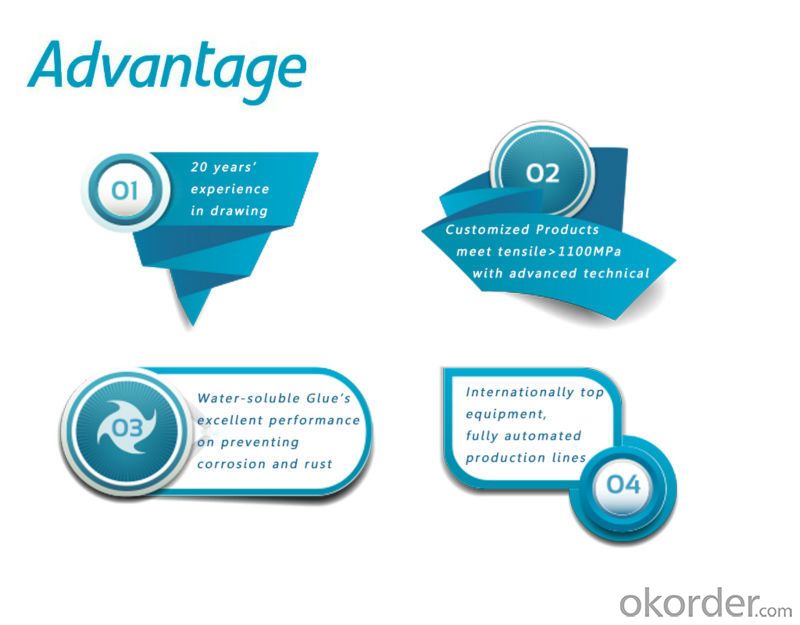
| Product | Diameter | Length mm/in | Aspect Ratio | Type | Packing |
| G-6030 | 0.5 mm (0.0197 in) | 30 mm (1.1811 in) | 60 | Glued | 20 kg/Bag, or 1,000kg/ Bulk Bag |
| G-6535 | 0.55 mm (0.0217 in) | 35 mm (1.3780 in) | 65 | Glued | 20 kg/Bag, or 1,000kg/ Bulk Bag |
| G-6035 | 0.6 mm (0.0236 in) | 35 mm (1.3780 in) | 60 | Glued | 20 kg/Bag, or 1,000kg/ Bulk Bag |
| G-8060 | 0.75 mm (0.0295 in) | 60 mm (2.3622 in) | 80 | Glued | 20 kg/Bag, 50 bags/Pallet |
| G-6060 | 0.9 mm (0.0354 in) | 60 mm (2.3622 in) | 60 | Glued | 20 kg/Bag, 50 bags/Pallet |
| G-6030 | 0.5 mm (0.0197 in) | 30 mm (1.1811 in) | 60 | Loose | 20 kg/Bag, or 1,000kg/ Bulk Bag |
| G-6535 | 0.55 mm (0.0217 in) | 35 mm (1.3780 in) | 65 | Loose | 20 kg/Bag, or 1,000kg/ Bulk Bag |
| G-6035 | 0.6 mm (0.0236 in) | 35 mm (1.3780 in) | 60 | Loose | 20 kg/Bag, or 1,000kg/ Bulk Bag |
| G-8060 | 0.75 mm (0.0295 in) | 60 mm (2.3622 in) | 80 | Loose | 20 kg/Bag, 50 bags/Pallet |
| G-6060 | 0.9 mm (0.0354 in) | 60 mm (2.3622 in) | 60 | Loose | 20 kg/Bag, 50 bags/Pallet |
- Q: Can melt extract stainless steel fiber be used in fiber-reinforced polymer (FRP) composites?
- Yes, melt extract stainless steel fiber can be used in fiber-reinforced polymer (FRP) composites. Melt extract stainless steel fiber is an ideal reinforcement material due to its high strength and corrosion resistance properties. It can enhance the mechanical properties of FRP composites, such as increasing their strength, stiffness, and impact resistance. Additionally, the addition of stainless steel fiber can improve the durability and fire resistance of FRP composites. Overall, melt extract stainless steel fiber is a suitable choice for reinforcing FRP composites, making them more robust and suitable for various applications in industries such as construction, automotive, and aerospace.
- Q: How does melt extract stainless steel fiber enhance the durability of concrete structures?
- The durability of concrete structures is greatly improved by the addition of melt extract stainless steel fiber. These fibers provide various advantages that contribute to the overall strength and longevity of the structure. To begin with, melt extract stainless steel fibers play a crucial role in enhancing the resistance to cracking in concrete. Acting as reinforcement, these fibers distribute stress and minimize the formation of shrinkage cracks. This is especially important in environments with extreme temperature variations or heavy loads, as it prevents the development of cracks that could compromise the structure's integrity. Furthermore, stainless steel fibers enhance the toughness and impact resistance of concrete. By dispersing throughout the concrete matrix, they create a three-dimensional network of reinforcement that improves the material's ability to absorb and distribute energy upon impact. This increased toughness prevents cracks from spreading, making the structure more durable and resistant to damage from external forces. Another significant advantage of melt extract stainless steel fibers is their ability to enhance the resistance to corrosion in concrete structures. Stainless steel is naturally resistant to rust and oxidation, even in harsh environments. By incorporating these fibers into the concrete mix, an additional layer of protection against corrosion is provided, thereby increasing the lifespan of the structure and reducing the need for maintenance and repair. Additionally, the use of melt extract stainless steel fibers can improve the fire resistance of concrete structures. Due to its high melting point, stainless steel helps delay structural failure under high temperatures when added to concrete. This is particularly important in buildings and structures where fire safety is a critical concern. In conclusion, the incorporation of melt extract stainless steel fibers significantly enhances the durability of concrete structures. By improving resistance to cracking, increasing toughness and impact resistance, enhancing corrosion resistance, and improving fire resistance, these fibers ensure that the concrete structure remains strong and intact for a longer period, reducing the need for repairs and replacements and ultimately saving costs.
- Q: Can melt extract stainless steel fiber be used in architectural concrete finishes?
- Yes, melt extract stainless steel fiber can be used in architectural concrete finishes. It is commonly used to improve the durability, strength, and crack resistance of concrete, making it suitable for various architectural applications.
- Q: Can melt extract stainless steel fiber improve the fatigue resistance of concrete?
- Yes, melt extract stainless steel fiber can improve the fatigue resistance of concrete. The addition of stainless steel fiber helps to enhance the overall strength and durability of the concrete, reducing the risk of cracking and structural failure under repeated loadings. It provides reinforcement, increased flexural strength, and crack resistance, thus improving the concrete's ability to withstand fatigue and prolong its service life.
- Q: What is the effect of melt extract stainless steel fiber on the fatigue life of asphalt mixtures?
- Incorporating melt extract stainless steel fibers into asphalt mixtures yields positive outcomes for the material's fatigue life. The purpose of adding these fibers is to enhance the mechanical properties of the asphalt mixtures and enhance their performance in repeated loading scenarios. The inclusion of stainless steel fibers in asphalt mixtures aids in bolstering resistance to fatigue cracking. Fatigue cracking is a common issue in asphalt pavements, particularly in areas with heavy traffic, as continuous vehicle loading weakens the material and causes it to crack eventually. Through the integration of stainless steel fibers, the asphalt mixture becomes more resilient, allowing it to endure higher levels of stress without developing cracks. The stainless steel fibers serve as reinforcement within the asphalt matrix, lending additional strength and improving material cohesion. This reinforcement effectively distributes the load evenly across the pavement, reducing stress concentration in specific areas and minimizing the formation of fatigue cracks. Moreover, the presence of stainless steel fibers in the asphalt mixture enhances its resistance to permanent deformation or rutting. Rutting occurs when the asphalt material deforms and permanently shifts under repeated traffic loads. The fibers play a crucial role in stabilizing the asphalt matrix, thereby preventing excessive deformation and maintaining the structural integrity of the pavement. Overall, the incorporation of melt extract stainless steel fibers into asphalt mixtures significantly improves the material's fatigue life. It enhances resistance to fatigue cracking and rutting, resulting in longer-lasting and more durable asphalt pavements. This can lead to reduced maintenance and repair costs, as well as enhanced safety and comfort for road users.
- Q: Is melt extract stainless steel fiber compatible with different types of fiber-reinforced polymers?
- Yes, melt extract stainless steel fiber is compatible with different types of fiber-reinforced polymers.
- Q: Can melt extract stainless steel fiber be used in high-rise building construction?
- Indeed, it is possible to utilize melt extract stainless steel fiber in the construction of high-rise buildings. Commonly employed in concrete, stainless steel fibers serve to enhance its mechanical properties, encompassing tensile strength, crack resistance, and impact resistance. In the context of high-rise buildings, where structural stability and longevity hold paramount importance, the incorporation of stainless steel fiber-reinforced concrete yields numerous advantages. Firstly, the introduction of stainless steel fibers augments the flexibility of the concrete, rendering it more resilient against cracking in the face of heavy loads or seismic activity. Such resistance is critical in high-rise buildings, as any fractures within the edifice could compromise its overall stability and safety. Secondly, stainless steel fibers also bolster the concrete's immunity to corrosion. Given the exposure of high-rise buildings to harsh environmental conditions, such as humidity, saltwater, and pollutants, the reinforcement within the concrete is prone to accelerated corrosion. However, through the integration of stainless steel fibers, the concrete gains heightened resistance to corrosion, thus prolonging the lifespan of the building. Moreover, stainless steel fibers play a role in enhancing the concrete's resistance to fire. In the event of a fire, these fibers contribute to containing the spread of flames, thereby reducing structural damage induced by elevated temperatures. This particular attribute assumes great significance in high-rise buildings, where fire safety ranks as a top priority. Collectively, the utilization of melt extract stainless steel fiber in high-rise building construction serves to augment the structural integrity, durability, and fire resistance of the concrete. By providing a reliable means of reinforcing the concrete, it ensures both the safety and longevity of the building.
- Q: Can melt extract stainless steel fiber be used in high-rise or tall buildings?
- Yes, melt extract stainless steel fiber can be used in high-rise or tall buildings. This type of fiber is known for its high strength and durability, making it suitable for various construction applications, including reinforcing concrete in tall buildings. It can enhance the structural integrity and resistance to cracking, improving the overall performance and safety of the building.
- Q: How does melt extract stainless steel fiber affect the shrinkage of concrete?
- Melt extract stainless steel fiber can significantly reduce the shrinkage of concrete. The fibers act as reinforcement within the concrete matrix, restraining the movement and cracking caused by shrinkage. This results in a more durable and crack-resistant concrete structure.
- Q: What is the impact of melt extract stainless steel fiber on the shrinkage of concrete?
- The use of melt extract stainless steel fiber in concrete can have a significant impact on the shrinkage of the material. Stainless steel fibers are typically added to concrete mixes to enhance its tensile strength and reduce cracking. When concrete undergoes the curing process, it tends to shrink due to the evaporation of water. This shrinkage can result in cracks and reduced durability of the structure. However, by incorporating melt extract stainless steel fibers into the concrete mix, the shrinkage can be effectively controlled and minimized. The stainless steel fibers act as reinforcement within the concrete matrix, helping to distribute the stress and strain more evenly. This reinforcement restrains the shrinkage of concrete and provides greater resistance to cracking. The improved tensile strength of the concrete also helps to limit the overall shrinkage, resulting in a more durable and long-lasting structure. Additionally, the melt extract stainless steel fibers have a high resistance to corrosion, which further enhances their effectiveness in mitigating shrinkage. This corrosion resistance ensures that the fibers maintain their structural integrity over time, even in harsh environmental conditions. Overall, the incorporation of melt extract stainless steel fibers in concrete can significantly reduce shrinkage and improve the overall performance of the material. By minimizing cracking and enhancing durability, structures built with this type of concrete can have a longer lifespan and require less maintenance.
Send your message to us
Melt Extract Stainless Steel Fiber 0.75/30 Concrete Steel Fiber from CNBM China
- Loading Port:
- Tianjin
- Payment Terms:
- TT OR LC
- Min Order Qty:
- 1 m.t.
- Supply Capability:
- 5000 m.t./month
OKorder Service Pledge
Quality Product, Order Online Tracking, Timely Delivery
OKorder Financial Service
Credit Rating, Credit Services, Credit Purchasing
Similar products
Hot products
Hot Searches
Related keywords


